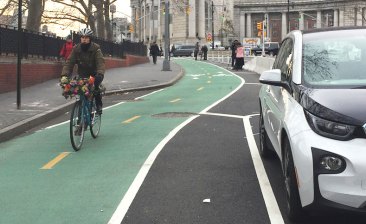DOT Commissioner: Bike Lane Delays Are Not About the Money!

Department of Transportation Commissioner Polly Trottenberg doesn’t need more cash to install the 50 miles of protected bike lanes a year that Council Speaker Corey Johnson wants — she just needs less bureaucracy.
Sure, it costs hundreds of thousands of dollars per mile to build a bike lane, but the real holdup, according to Trottenberg, is having to get support from nearly everyone that would even look at the bike lane: community boards, local pols, and the surrounding neighborhood. That’s the problem, she said, especially when many business owners fear that a reduction in curbside parking would hurt their bottom lines.
“I’ll reiterate the price tag is not an enormous cost,” said Trottenberg after a City Council budget hearing about how the Department of Transportation will spend $1.01 billion in fiscal year 2020. “The challenge of building out the bike network is really the labor intensive side — it’s going to local communities, it’s working through the engineering, it’s working with the businesses and residents that are at the curb. It’s going to community boards, that’s the piece that’s sort of the biggest challenge to building out the bike network.”
Trottenberg’s explanation comes a week after Johnson unveiled a master street-safety plan that would let transportation officials speed up the rate of installing bike lanes without getting “bogged down … by opposition from communities and elected officials.”
“While the City has made some progress to increase rates of cycling and improve cyclist safety, progress to invest in the most effective intervention—protected bike lanes—has moved far too slowly,” Johnson wrote in his 100-page “Let’s Go” report.
Trottenberg has previously brushed off the need for more funding from Council in order to devote more resources to street redesigns that will save lives, and she reiterated that fact again on Thursday on the heels of Johnson’s demands for overhauling the way the city installs bike lanes.
“It’s not a financial challenge,” she said.
Trottenberg was likely referring to battles like the Skillman Avenue bike lane, which was voted down by the local community board only to be implemented anyway by Mayor de Blasio. Meanwhile, the very same mayor removed protected bike lanes on Dyckman Street this past summer after backlash from the community. And in 2016, the Department of Transportation gave up on its plan to install a two-way protected bike lane on Clinton Avenue after longtime residents rallied against it.
If Johnson’s system were already in effect, it’s likely there would be more bike lanes on city streets now. At the very least, it holds out the promise that street-safety improvements would simply be implemented rather than debated — since the debate has long been settled in favor of better design.
During the budget hearing, Trottenberg broke down how the Department of Transportation plans to spend the $1.01 billion: $275 million for traffic operations, like signals, streetlights, and parking; $165 million for roadway maintenance; $110 million for bridge maintenance; $107 million for transportation planning and management, like street sign installation and roadway markings; $105 million for ferry operations; and $250 million for other department operations, like sidewalk management and inspection.
Council Members on the Transportation Committee also grilled Trottenberg about the need for road resurfacing, more protected bike lanes, and how to stop reckless drivers on city streets. Many of those reckless recidivist drivers are cops, as Streetsblog’s ongoing series has shown.
